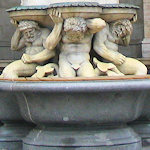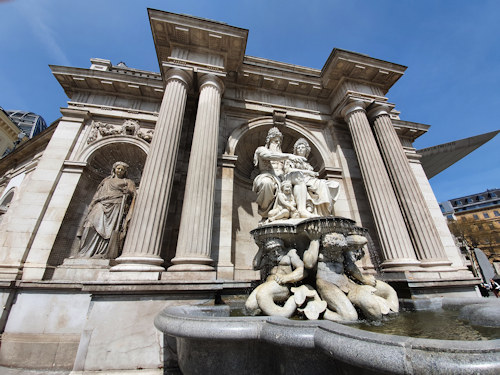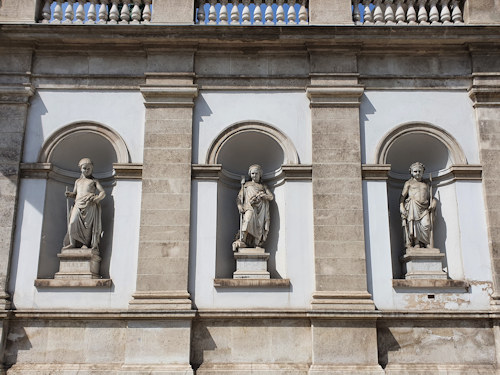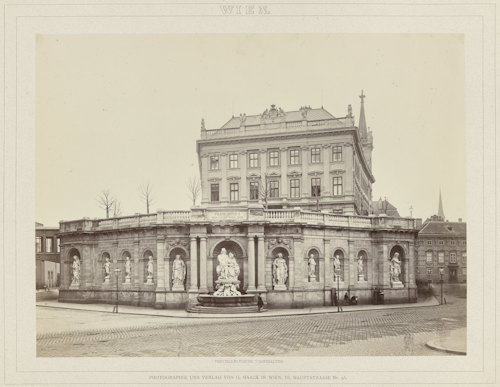
“If you’ve got it, flaunt it,” as the saying goes. Austria-Hungary had a lot of lands with some rather fine waterways running through them.
So what better way to point out (once again) the magnificence of the empire than a river-themed monumental fountain?
- 1869 wall fountain between the Albertina and State Opera House
- Honours the association between Vienna, the Danube and various of the latter’s tributaries
- Original was slightly wider, with two extra allegorical river figures
- Book a walking tour* of Vienna
- See also other famous fountains:
The Danubiusbrunnen

(View across Albertinaplatz square)
When the state decided to take down the Vienna fortifications in the 19th century and open up the area to development, they sold off some of the land for private construction projects and used the money for public ones.
One of the projects so financed was a decorative Renaissance-style wall fountain and monument at the base of one of the few parts of the city walls that remained largely intact (presumably since a rather splendid palais – now the Albertina art museum – stood more or less on top of it).
The fountain bears the name Albrechtsbrunnen, named for Archduke Albrecht (owner of that palais and the guy riding the horse in the statue on the plateau above the fountain).
Locals also refer to the location as the Danubiusbrunnen, because of the figure of Danubius at the centrepiece of the installation and the overarching Danube theme.

(Each figure used marble from Carrara in Italy; the same source provided stone used in such iconic creations as the Pantheon in Rome, Michelangelo’s David, and London’s Marble Arch)
Unveiled in 1869 on Emperor Franz Joseph’s birthday, this long monument features allegorical figures for Vienna, the Danube river and major tributaries of the Danube that passed through imperial lands.
In the central water feature, three tritons support the seated Danubius (the Danube) with his arm around the female Vindobona (representing Vienna itself).
The other figures along the length of the original monument represented:
- The Inn (actually begins in Switzerland, passes through Innsbruck and joins the Danube at Passau)
- The Save (crossed what would have been the southern part of the empire before reaching the Danube at Belgrade)
- The Drava (runs a little north of the Save and joins the Danube at Osijek in what was then Croatia-Slavonia)
- The Tisza (which crossed the Kingdom of Hungary from north to south)
- The Mur (begins in the Austrian alps and flows through Graz before eventually merging with the Drava)

(Three rivers in human form)
- The Salzach (the river that runs through Salzburg and flows into the Inn)
- The Morava (which gave its name to Moravia and reaches the Danube just outside Bratislava)
- The Rába (which flows through Austria and Hungary, where it joins the Danube at Gyor)
- The Enns (a small Austrian tributary known for its wild waters)
- The Traun (another small Austrian tributary)
The Enns and Traun rivers also feature in the Donnerbrunnen fountain on nearby Neuer Markt square.
Today’s monument is shorter and has fewer figures than the original, as you can tell by comparing the photos with one from the late 19th century. The two end niches are missing:

(Photo kindly provided by the Rijksmuseum)
Unfortunately, the wall fountain suffered damage in WWII and some of the figures subsequently found new homes. Renovation work earlier this century brought back all but three figures into the slightly downsized original.
Of the three missing figures, the Inn and Drava now live in the Burggarten; the March has seemingly dried up (i.e. it went completely missing) and the figure you see today is a copy.
How to get to the Albrechtsbrunnen
Just follow the tips for the Albertina. You may find your view of the wall fountain obscured by queues for the well-known Bitzinger Würstelstand (sausage seller) just off to one side of the square.
Alternatively, watch the movie The Woman in Gold; the fountain makes a brief appearance in a shot out of a hotel window.
Address: Albertinaplatz, 1010 Vienna